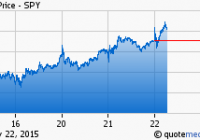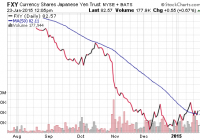Go Long SPY Now – Market Turn At Hand
The market has accounted for its fear of the ECB and Greece year-to-date, and I believe stocks have mostly sold off in 2015 because of rumors around these events. But as rumor fades into news, stocks are poised to enjoy a relief rally, and SPY is already off its lows marked on January 15. While the Greek election results are likely to revive some fear next week, I am already taking long stakes in stocks and view SPY okay to buy in increments. It’s time to start going long the SPDR S&P 500 Trust ETF (NYSE: SPY ), aka the U.S. market, as I see a turn sometime between last week’s low and the end of the month. If I am correct that the European Central Bank (ECB) action and the Greek election and its potential repercussions have greatly swayed currencies, commodities and stocks year-to-date, then a turn may be in store in the very near-term. My reasoning is based on my belief that stocks have mostly priced in worst case scenario fueled fear, and that reality will be much less scary than expectations. Stocks seem to have already found stability, with a recent bottom marked on January 15 for SPY; and many names are rising into their earnings events now, some of which I have taken long stakes in over the past week. I’ll talk about those in dedicated articles. The market has priced in a ton of fear year-to-date, I believe around the Greek election and its potential election to drop out of (or be dropped out of) the euro-zone thereafter if the big demands of its expected new leadership are not met. But, I expect the end result of events in Greece will prove much less threatening than the market has priced in, offering opportunity for relief rally as events unfold this weekend and next month. Thus, we appear to have set up for a sell the rumor, buy the news turn of events, and it’s about time to start buying in increments here. Volatility has dropped off significantly over the last two trading days, and I’m pulling my hair out for not taking that short position in the iPath S&P 500 VIX Short Term Futures ETN (NYSE: VXX ) I had been contemplating through put options. We may get another spike in the VXX Monday after the Greek election results come in, so there could be another opportunity yet. But as for the market generally, I think it’s okay to start taking stakes in stocks again and the SPDR S&P 500 is a great way to do that. I surveyed some of my Greek contacts and have contemplated the situation; there seems to be the possibility that risk may have been overly priced into stocks around the Greek election due on Sunday. The new disruptive political party Wall Street and Brussels are concerned about, Syriza, is not the threat to European and global stability our press indicates it is. Yes, Syriza will push for renegotiation of the terms of the money Greece owes its European partners and other parties, but it will not default on that debt in my view. In other words, a Grexit is not going to happen as far as I see it. SPY’s page at Seeking Alpha shows it is only down 1.2% year-to-date after gaining back roughly 2.9% since the January 15 close. Many pundits I’ve seen talk about the market seem to conclude the valuation of the S&P 500 Index is not so cheap, with an index P/E multiple of roughly 18.8X, versus historical mean closer to 15.5X. However, the index multiple on forward estimates is 16.65X according to the WSJ page linked to above. Let’s not forget that our economy is growing at an accelerating pace and that the unemployment rate has been decreasing at a better than expected rate. Europe has its stimulus now, but the region’s decline and even China’s slowing growth are not a huge a threat to our economy anyway; that is especially true now that gasoline prices have come down so much (I’m looking for oil prices to stabilize and rise soon). My friends, I say face fear and start buying stocks now in increments and more so as we get passed this Greek election event. It will drive fear again into stocks next week, but I expect that would only open further opportunity for U.S. investors to buy SPY and stocks generally for benefit later this year. This thing has been overblown. My mouth is watering over some of the valuations I see considering this economy’s strength, so I’m gritting my teeth and buying stocks.

